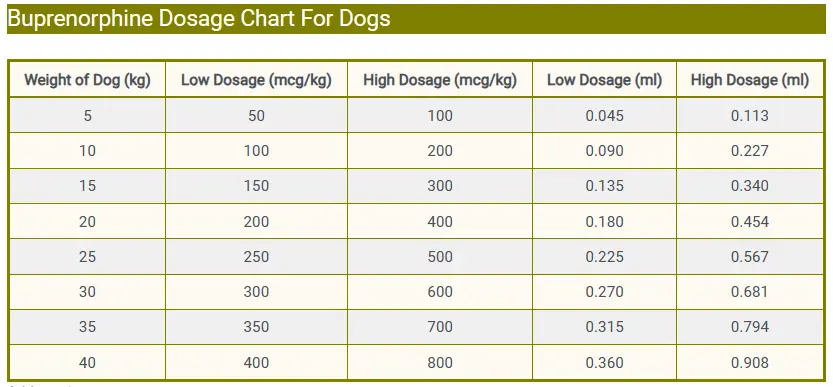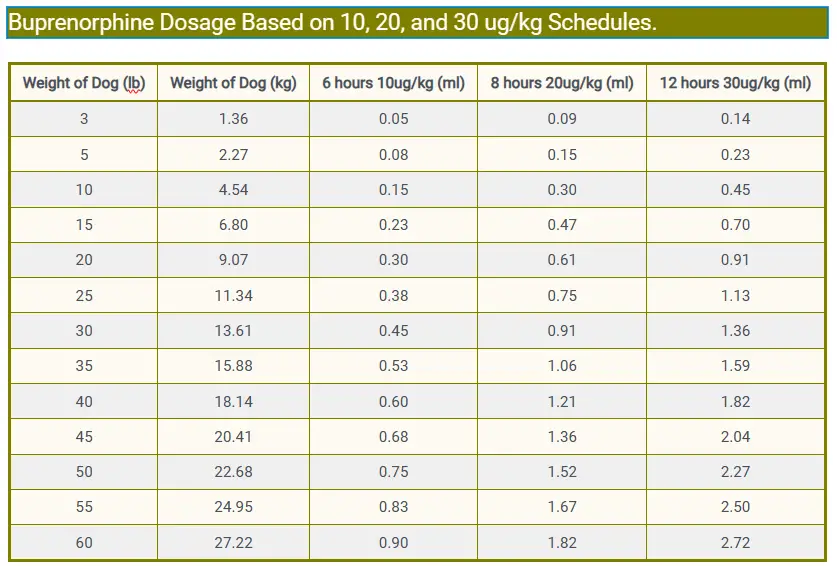The ideal Buprenorphine (0.3 mg/ml) dosage for dogs for pain relief is 10 – 20 micrograms per kilogram (0.3 – 0.6 ml per 10 kg). The dosage is administered based on three options: 10, 20, and 30 ug/kg dosing schedules. However, the dose can be adjusted, either increased or decreased, based on your pet’s age and condition.
Buprenorphine Dosage For Dogs

-
Ideal Dose: 10 – 20 micrograms per kilogram.
-
Uses: Pain Reliever.
-
FDA Approved: No.
-
Variants: Injectables.
-
Storage & Handling: 20° to 25°C (68° to 77°F)
-
Administration: As vet prescribe.
Disclaimer: Self-medication can be hazardous. Please consult your veterinarian for personalized guidance on the appropriate dosage for your furry friend’s specific condition.
In recent years, the use of buprenorphine (Buprenex®) in veterinary medicine has gained significant attention, particularly in the realm of pain management for dogs. As pet owners increasingly seek compassionate and effective ways to alleviate their canine companions’ discomfort, understanding the appropriate dosage of buprenorphine becomes crucial.
In this guide, we delve into the nuances of administering buprenorphine to canines, exploring dosage considerations, efficacy, and safety measures to ensure optimal care for our furry friends.
What Is Buprenorphine For Dogs?
Buprenorphine for dogs is a medication primarily used to manage pain in dogs, particularly after surgery or in cases of chronic pain. Buprenorphine (Buprenex®) belongs to a class of drugs called opioids, which work by binding to opioid receptors in the brain and spinal cord, thereby reducing the perception of pain.
It’s often used because it provides effective pain relief with fewer side effects compared to some other opioids.
However, like all medications, it should only be used under the guidance of a veterinarian to ensure proper dosage and monitoring for any potential side effects.
Buprenorphine Dosage For Dogs
The typical starting dose of buprenorphine for dogs ranges from 0.009-0.227 ml/kg (0.02 to 0.5 ml/lb), depending on dosing schedules of 10, 20, and 30 micrograms per kilogram, administered orally or via injection for pain relief.
However, Buprenex® dosages may differ, so it’s crucial to adhere closely to your veterinarian’s instructions. They’ll assess your dog’s individual needs to determine the correct dosage and administration schedule.
Buprenorphine Dosage Chart For Dogs
| Weight of Dog (kg) | Low Dosage (mcg/kg) | High Dosage (mcg/kg) | Low Dosage (ml) | High Dosage (ml) |
|---|---|---|---|---|
| 5 | 50 | 100 | 0.045 | 0.113 |
| 10 | 100 | 200 | 0.090 | 0.227 |
| 15 | 150 | 300 | 0.135 | 0.340 |
| 20 | 200 | 400 | 0.180 | 0.454 |
| 25 | 250 | 500 | 0.225 | 0.567 |
| 30 | 300 | 600 | 0.270 | 0.681 |
| 35 | 350 | 700 | 0.315 | 0.794 |
| 40 | 400 | 800 | 0.360 | 0.908 |
The above Buprenorphine dosage chart for dogs by weight is provided for educational purposes only and should not substitute for veterinary advice. Always start with the minimum dose for you feline until your vet prescribes an increase in dosage.
Buprenorphine Dosage Based on 10, 20, and 30 ug/kg Schedules.
| Weight of Dog (lb) | Weight of Dog (kg) | 6 hours 10ug/kg (ml) | 8 hours 20ug/kg (ml) | 12 hours 30ug/kg (ml) |
|---|---|---|---|---|
| 3 | 1.36 | 0.05 | 0.09 | 0.14 |
| 5 | 2.27 | 0.08 | 0.15 | 0.23 |
| 10 | 4.54 | 0.15 | 0.30 | 0.45 |
| 15 | 6.80 | 0.23 | 0.47 | 0.70 |
| 20 | 9.07 | 0.30 | 0.61 | 0.91 |
| 25 | 11.34 | 0.38 | 0.75 | 1.13 |
| 30 | 13.61 | 0.45 | 0.91 | 1.36 |
| 35 | 15.88 | 0.53 | 1.06 | 1.59 |
| 40 | 18.14 | 0.60 | 1.21 | 1.82 |
| 45 | 20.41 | 0.68 | 1.36 | 2.04 |
| 50 | 22.68 | 0.75 | 1.52 | 2.27 |
| 55 | 24.95 | 0.83 | 1.67 | 2.50 |
| 60 | 27.22 | 0.90 | 1.82 | 2.72 |
Related Post: Panacur Dosage For Dogs
Buprenorphine Uses in Dogs
-
Buprenorphine is used in dogs for pain management.
-
It helps alleviate moderate to severe pain after surgery, injury, or due to chronic conditions like arthritis.
-
Buprenorphine can also be used to sedate dogs before procedures or examinations.
-
Dogs with chronic pain conditions such as cancer or joint disease may benefit from buprenorphine.
-
It may be used to manage withdrawal symptoms in dogs weaning off opioid medications.
-
Always administer buprenorphine under veterinary guidance to ensure proper dosing and monitoring.
Related Post: Phenylpropanolamine Dosage For Dogs
Buprenorphine Side Effects in Dogs
-
Respiratory depression: Decreased breathing rate, especially at higher doses.
-
Gastrointestinal upset: Nausea, vomiting, or constipation may occur.
-
Sedation: Can induce drowsiness or lethargy.
-
Behavioral changes: Dogs may show altered activity levels or agitation.
-
Allergic reactions: Rarely, itching, swelling, or difficulty breathing may occur.
-
Dependence and withdrawal: Prolonged use may lead to physical dependence and withdrawal symptoms if abruptly stopped.
Which Dogs Should Not Take Buprenorphine.
Canines with the following health issues should not take Buprenorphine without veterinary recommendations.
-
Dogs allergic to buprenorphine or opioids should avoid it.
-
Dogs with severe respiratory conditions should not take buprenorphine due to its potential to cause respiratory depression.
-
Canines with impaired liver or kidney function may not process buprenorphine properly, leading to adverse effects or toxicity.
-
Buprenorphine may worsen severe gastrointestinal issues like bowel obstruction or paralytic ileus.
-
Caution is needed when administering buprenorphine alongside certain medications, as interactions may occur.
-
The safety of buprenorphine in pregnant or nursing dogs is uncertain and should be carefully considered.
FAQs
Can I give my dog buprenorphine without consulting a veterinarian?
It’s strongly recommended to consult with a veterinarian before administering any medication to your dog, including buprenorphine. Veterinarians can assess your dog’s condition and provide appropriate guidance on dosage and administration.
How long does buprenorphine take to work in dogs?
Buprenorphine typically starts to take effect within 30 to 60 minutes after administration, providing rapid pain relief for dogs.
What should I do if I miss a dose of buprenorphine for my dog?
If you miss a dose of buprenorphine for your dog, contact your veterinarian for guidance. Avoid doubling the next dose unless specifically instructed by your veterinarian.
Can buprenorphine be used long-term in dogs?
Buprenorphine can be used for long-term pain management in dogs under the supervision of a veterinarian. Regular monitoring and adjustments to the dosage may be necessary to maintain efficacy.
Are there any alternative pain medications for dogs besides buprenorphine?
Yes, there are several alternative pain medications available for dogs, including nonsteroidal anti-inflammatory drugs (NSAIDs), tramadol, and gabapentin. Your veterinarian can help determine the most appropriate option based on your dog’s individual needs.





![Can Dogs Eat Blood? 7 Side Effects [Expert Opinion]](https://petskor.com/wp-content/uploads/2022/04/Webp.net-resizeimage-12.jpg)
